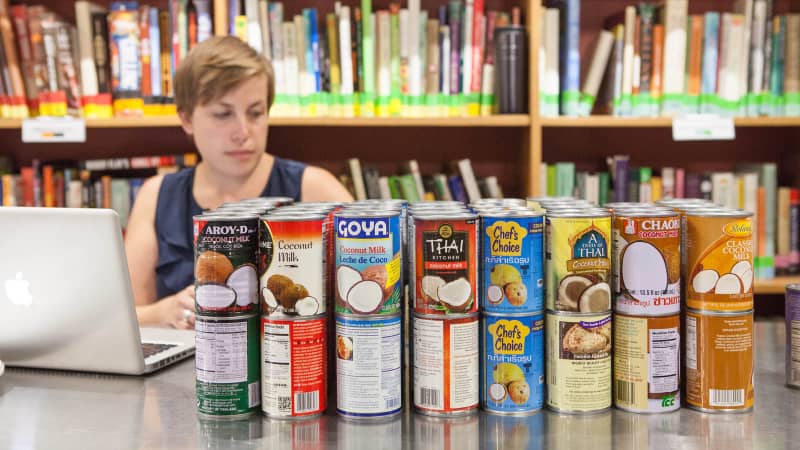Unsweetened Shredded Coconut
Taste Test
We were shocked by the dramatic differences among canned coconut milks.
Published May 1, 2017. Appears in America's Test Kitchen TV Season 18: Pad Thai and Panang Curry

If you crack open a coconut, the thin liquid that pours out is coconut water. It has gained recent popularity as a sports drink, but we don’t have much use for it in the test kitchen. We also tend to stay away from cream of coconut, the extra-thick and sweetened stuff, unless we’re making a tropical cocktail. Instead, the test kitchen’s go-to coconut liquid is coconut milk. It’s made by shredding fresh coconut meat and pressing it to extract liquid, sometimes adding a small amount of water to help the process. Coconut milk is a key ingredient in many puddings and pies and a staple in Southeast Asian soups, sauces, curries, and stir-fries.
When we last reviewed coconut milk, we preferred regular, full-fat versions to light alternatives and named Chaokoh, an ultracreamy Thai import, our winner. To find out if any new contenders could best our old favorite, we rounded up seven products, priced from $0.99 to $3.29 for a roughly 14-ounce can. We sampled them three times in blind tastings: plain (to get a sense of their differences), and then in coconut rice pudding and Thai-style chicken soup.
Before we even got to tasting, though, we were surprised by the dramatic differences among the products when we opened the cans. Although we think of it as a single ingredient, coconut milk is technically an emulsion of coconut oil, coconut protein, and water. Because coconut oil solidifies into coconut cream at room temperature, canned coconut milk generally separates into two distinct layers: liquid water at the bottom and solid white cream at the top. The cream in some cans was as heavy and dense as Crisco, while in others it had a looser consistency. The colors ranged from gray to snowy white. The liquid also varied. In some cans, it was opaque and smooth in consistency. In others, the liquid was cloudy, with little specks of cream. And, to our surprise, the ratio of cream to water differed in each product. When we separated the two components, some had a roughly 50/50 balance, while others contained almost no liquid.
Why so different? It turns out that the U.S. Food and Drug Administration doesn’t regulate the term “coconut milk,” and each manufacturer is able to set its own standards on how concentrated and/or fatty its product might be. (There are also no standards for how ingredients appear on the label. Two products listed “coconut extract” instead of “coconut milk” on their labels, but after talking to experts we concluded that these were one and the same.) Some factors (such as the amount of water added) are easy for manufacturers to adjust, but Dr. Nattapol Tangsuphoon, a professor of food science at Mahidol University in Thail...
The mission of America’s Test Kitchen Reviews is to find the best equipment and ingredients for the home cook through rigorous, hands-on testing.

Kate is a deputy editor for ATK Reviews. She's a culinary school graduate and former line cook and cheesemonger.

This is a members' feature.